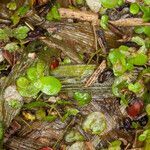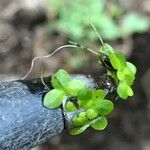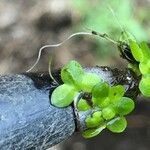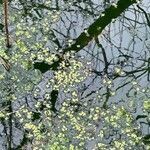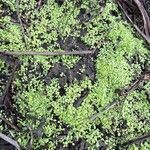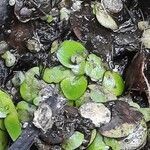Fronds free floating on water surface, 1-8 coherent in one small group, without green stalk at base (but with a thin white stipe connecting fronds), shiny green, sometimes reddish on upper surface, scarcely reddish on lower surface (always deeper red on upper surface than on lower), obovate to elliptic, 2-6(-10) mm, 1.3-2 × as long as wide, flat, with mostly distinct papillae on upper surface near apex and above node, margin entire, base rounded; veins 3(-5), nearly reaching apex, greatest distance between lateral veins near or proximal to middle. Root 0.5-15 cm, sheath not winged, apex mostly rounded. Turions absent. Ovary with 1 ovule; utricular scale with narrow opening at apex. Fruit winged laterally toward apex. Seed with 10-16 distinct ribs. Fl. (rare) May-Sep. 2n = 20, 40, 42, 50, 63, 126.
Small floating aquatic. Fronds solitary or cohering in groups of 2-5 (sometimes many more), symmetric to slightly asymmetric, round-elliptic to elliptic or ovate; 1.5-4.6 by 1-2.9 mm; base ± symmetric, obtuse; apex symmetric or slightly asymmetric; margin entire; dorsal side flat to slightly convex, often with a median row of papillae; ventral side flat to slightly convex; cells on ventral side not visible to the naked eye, green; nerves 3. Stipe often persistent and prominent; root sheath cylindrical, without wings, root cap obtuse. Slit of budding pouch coinciding with the margin of the frond. Ovary with 1 amphitropous ovule. Fruit ellipsoid, symmetric, laterally compressed, without wings. Seed smooth.
Fronds floating on water surface, obovate, with obtuse to shortly pointed tip, 1–8 mm long, 1.3–2 times as long as wide, flat, entire, with an indistinct papule near apex and above node, sometimes diffusely red coloured on upper surface, but not on lower surface, without green stalk; nerves 3–5 (if more than 3 nerves then outer ones branching from base of inner ones); air spaces in 2 or 3 layers spreading through most of frond, shorter than 0.3 mm. No distinct turions present. Roots to 15 cm long; sheath not winged; tip usually rounded. Flowers 1-ovulate. Fruit 0.8–1.0 mm long, with lateral wings towards top. Seeds with 8–15 distinct ribs.
Thallus rotund to elliptic or obovate, (1.5–)2.5–6 mm, nearly symmetrical, commonly in groups of 2–5, very often anthocyanic beneath, dark green above, or anthocyanic on both sides, ± evidently 3-nerved, usually flat or only slightly convex on both sides, the upper surface with ± prominent papillae; spathe sac-like, open only at the top; fr not winged; seed solitary, smooth or only inconspicuously ribbed; 2n=20, 30, 40, 50. Nearly cosmop., and common throughout our range. (L. obscura, a small form; L. turionifera, overwintering by small, rootless turions at the bottom of the water)
Perennial herb, hydrophyte. Fronds floating, flattened, 1-8 x 0.6-5.0 mm, up to 1 mm thick, adaxial surface green or tinged with red, without red flecks, with indistinct papillae along midvein; abaxial surface usually without colour or slightly reddish, flat; largest gas-filled chambers < 0.3 mm in diam. Root usually exceeding 30 mm long; sheath not winged, cap rounded. Seed 1 per fruit, 0.7-1.0 x 0.4-0.6 mm whitish, with 10-16 longitudinal ribs.
Free-floating aquatic.. Thallus dark green, symmetrical, flat, oblong-ovate. 2.5–6 mm. long, 1.5–4 mm. wide, rather obscurely 3-nerved, without large airspaces evident beneath.. Root solitary, arising along a shallow groove; sheath unwinged; root-cap obtuse.. Floral pocket lateral; spathe open at the top.. Staminate flowers 2, each with a single stamen.. Pistillate flower solitary.. Seed solitary, not ribbed, reticulate.. Fig. 1/3, p. 3.
A herb. It grows in water. The fronds are free floating. They are shiny green and cling together in small groups. The plant body is 0.1-0.4 cm long and oval. They have one root hanging down from each leaf. There are very small male and female flowers.
Aquatic herb. Root sheath not winged. Root tip mostly rounded. Roots often longer than 30 mm. Fronds often red below, or with red spots on either side, ± round.
Minute, floating aquatic forming colonies. Leaves thin. Flowers minute.
